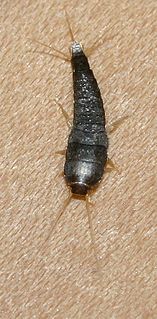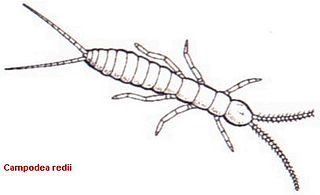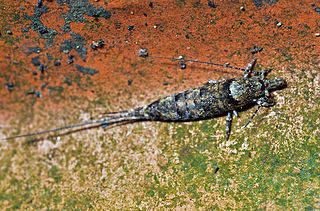This is a timeline of aviation history, and a list of more detailed aviation timelines. The text in the diagram are clickable links to articles.
At the end of each Major League Baseball season, the league leaders of various statistical categories are announced. Leading either the American League or the National League in a particular category is referred to as a title.
This is a list of international organization leaders in any given year.

The Machilidae are a family of insects belonging to the order Archaeognatha. There are around 250 described species worldwide. These insects are wingless, elongated and more or less cylindrical with a distinctive humped thorax and covered with tiny, close-fitting scales. The colour is usually grey or brown, sometimes intricately patterned. There are three "tails" at the rear of the abdomen: two cerci and a long central epiproct. They have large compound eyes, often meeting at a central point. They resemble the silverfish and the firebrat, which are from a different order, Zygentoma.

Lepismatidae is a family of primitive wingless insects with about 190 described species. This family contains the two most familiar members of the order Zygentoma: the silverfish and the firebrat. It is one of five families in the order Zygentoma.

Ctenolepisma is a genus of primitive insects in the order Zygentoma, closely related to the silverfish and firebrat but less reliant on human habitation, some species being found both indoors and outdoors and some found exclusively outdoors. The genus is distributed nearly worldwide in warm regions. Australia lacks native Ctenolepisma, but is home to introduced species.

The Campodeidae are a family of hexapods belonging to the order Diplura. These pale, eyeless hexapods, the largest of which grow to around 12 mm in length, can be recognised by the two long, many-segmented cerci at the end of the abdomen. Abdominal spiracles are absent.
The following is a list of players, both past and current, who appeared in at least one game for the New York Yankees franchise, including the 1901–02 Baltimore Orioles, and the 1903–12 New York Highlanders.
The table of years in radio is a tabular display of all years in radio, for overview and quick navigation to any year.
Neoasterolepisma is a genus of primitive insects belonging to the family Lepismatidae. Many species live with ants.
Symphylurinus is a genus of diplurans in the family Projapygidae.
This is a table of articles relating to the environment by year. They relate to environmental law, conservation, environmentalism and environmental issues.
Allopsontus is a genus of the family Machilidae which belongs to the insect order Archaeognatha. Certain species in this genus have been found as high as 5 kilometres above sea level on the Himalayas.
Charimachilis is a genus of the family Machilidae which belongs to the insect order Archaeognatha. They are found in southern and eastern Europe.
Silvestrichilis is a genus of jumping bristletails in the family Machilidae. There are about eight described species in Silvestrichilis.

Trigoniophthalmus is a genus of jumping bristletails in the family Machilidae. There are about 11 described species in Trigoniophthalmus.
Sceletolepisma is a genus of primitive insects closely related to the silverfish and firebrat but less reliant on human habitation, some species being found both indoors and outdoors and some found exclusively outdoors. The genus is distributed nearly worldwide in warm regions.




